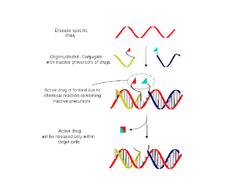Chemistry:Nucleic acid templated chemistry
Nucleic acid templated chemistry (NATC), or DNA-templated chemistry, is a tool used in the controlled synthesis of chemical compounds. The main advantage of NAT-chemistry (NATC) is that it allows the user to perform the chemical reaction as an intramolecular reaction. Two oligonucleotides. or their analogues, are linked via chemical groups to precursors of chemical compounds. The oligonucleotides recognize specific nucleic acids and are hybridized sterically close to each other. Afterwards, the chemical active groups interact with each other to combine the precursors into a completely new chemical compound. NATC is usually used to perform synthesis of complex compounds without the need to protect chemically active groups during the synthesis.
In 1999 Pavel Sergeev suggested the use of NATC to synthesize biologically active compounds within living organisms.,[1] including use within human cells. In this application, the precursors are distributed in the whole human body and the chemical reactions are performed only within cells having specific RNA molecules. This approach allows very specific synthesis within particular tissues or within specific cells of the tissue. It is especially a new tool to deliver medications to cancer cells. Additionally biologically active compounds could be delivered to specific cells within humans to promote the targeted cells to divisions. NATC also opens the possibility to treat bacterial diseases. Many scientific groups have performed NATC in vivo to visualize eukaryotic as well as bacterial cells. As a principle, it may be employed to treat oncological and bacterial diseases, as well as to visualize them.[2][3][4][5][6][7]
See also
References
- ↑ Sergeev, Pavel, Patent application, WO200061775, filling date 8 April 1999 "Synthesis of biologically active compounds in cells" PCT/IB1999/000616.
- ↑ "Efficient nucleic acid detection by templated reductive quencher release". J Am Chem Soc 131 (44): 16021–16023. November 2009. doi:10.1021/ja904138v. PMID 19886694.
- ↑ "DNA-templated polymerization of side-chain-functionalized peptide nucleic acid aldehydes.". J. Am. Chem. Soc. 130 (14): 4646–4652. April 2008. doi:10.1021/ja0753997. PMID 18341334.
- ↑ "Effects of Template Sequence and Secondary Structure on DNA-Templated Reactivity.". J. Am. Chem. Soc. 130 (4): 1392–1401. January 2008. doi:10.1021/ja076780u. PMID 18179216.
- ↑ "New, Stronger Nucleophiles for Nucleic Acid-Templated Chemistry: Synthesis and Application in Fluorescence Detection of Cellular RNA.". Bioorg. Med. Chem. 16 (1): 56–64. January 2008. doi:10.1016/j.bmc.2007.04.051. PMID 17502150.
- ↑ "DNA-templated homo- and heterodimerization of peptide nucleic acid encoded oligosaccharides that mimic the carbohydrate epitope of HIV.". Angew. Chem. Int. Ed. Engl. 48 (41): 7695–7700. April 2009. doi:10.1002/anie.200903328. PMID 19774579. http://www3.interscience.wiley.com/journal/122603817/abstract.
- ↑ "Imaging of mRNA in live cells using nucleic acid-templated reduction of azidorhodamine probes.". J. Am. Chem. Soc. 131 (19): 6492–6497. May 2009. doi:10.1021/ja809656k. PMID 19378999.
 |



